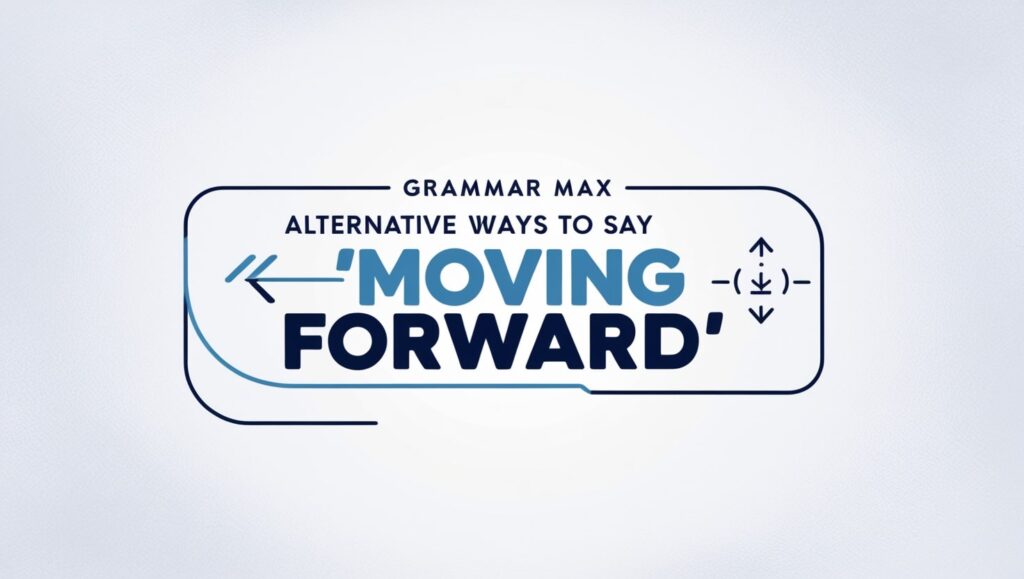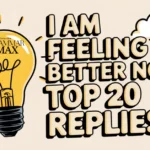In professional communication, using alternative phrases to express future actions or directions can enhance clarity and engagement. Here are 23 professional alternatives to say “Moving Forward,” with best-use scenarios and examples, ideal for emails or other formal communications.
Alternative ways to say “Moving Forward”

Here’s alternative ways to say “Moving Forward” professionally:
- Going Forward
- From This Point Forward
- Looking Ahead
- Henceforth
- Advancing
- Future Planning
- As We Progress
- To Move Forward
- Forward-Looking
- From Now On
- Considering Future Actions
- Into the Future
- As We Forge Ahead
- The Road Ahead
- Moving Forward in Email
- Progressing
- As We Transition
- The Path Ahead
- Future-Focused
- Onward
- New Horizons
- Into New Phases
- Strategic Advancements
1. Going Forward
One of the most common and effective alternatives, “Going Forward” implies a progressive outlook. It’s commonly used in strategic communication and business planning.
Best Use:
Use this in emails to signal future actions or directions in project updates.
Example:
“Hi Sarah, Going forward, our team will focus on improving communication with clients to ensure timely feedback. Let’s discuss this further in our next meeting.”2. From This Point Forward
This phrase emphasizes a definitive transition in processes or strategies. It is great for highlighting a change in course or the start of a new policy.
Best Use:
Ideal for addressing organizational changes or new policies in an email.
Example:
“Hi Thomas, From this point forward, all reports must be submitted by the 5th of each month to streamline our processes.”3. Looking Ahead
“Looking Ahead” carries a forward-thinking tone, which is perfect for discussions involving strategic planning and long-term goals.
Best Use:
Use this phrase when outlining future-focused strategies or upcoming plans.
Example:
“Dear Team, Looking ahead, we’ll prioritize sustainability in all our projects, aligning with our long-term business strategies.”4. Another Way to Say Moving Forward: “Henceforth”
Using “Henceforth” conveys a formal tone, typically for official documents or important changes in business processes.
Best Use:
Perfect for official statements or formal emails.
Example:
“Dear John, Henceforth, we will be transitioning to a new project management tool to ensure better resource management.”5. Advancing
This synonym for “Moving Forward” is excellent for showcasing progress and continuous improvement in team projects or leadership discussions.
Best Use:
Use this when discussing team collaboration or milestones.
Example:
“Hi Maria, As we continue advancing on the current project, let’s ensure all feedback is consolidated before the deadline.”6. Future Planning
When addressing strategic communication, “Future Planning” effectively captures the essence of looking beyond the present into the road ahead.
Best Use:
Ideal for planning meetings, goal setting, or decision-making processes.
Example:
“Hi Emily, During our future planning session, we’ll cover the next quarter’s objectives, focusing on innovation and adaptability.”7. As We Progress
This phrase emphasizes steady development and is great for communicating how work is continuing to move forward, particularly in team development scenarios.
Best Use:
Suitable for project updates and emails involving team collaboration.
Example:
“Hi Team, As we progress on the client presentation, let’s focus on incorporating the latest data insights.”8. To Move Forward
This phrase is slightly more active, implying immediate action. It’s perfect for guiding teams or clients toward next steps in business processes.
Best Use:
Use in emails or meetings to outline future actions.
Example:
“Hi Jason, To move forward with the new policy implementation, please provide an updated timeline by next week.”9. Forward-Looking
“Forward-Looking” is great for presenting a positive, future-oriented mindset. It works well when discussing future-focused strategies or organizational change.
Best Use:
Ideal for leadership meetings or discussing long-term goals.
Example:
“Dear Board Members, Our forward-looking strategy for the next year includes embracing new technologies and enhancing business progress.”10. From Now On
Another way to say moving forward, “From Now On” is direct and clear, signaling a new way of operating or thinking within a company.
Best Use:
Useful when announcing new policies or changes in business processes.
Example:
“Hi Everyone, From now on, we will be implementing weekly check-ins to improve project milestones and communication.”11. Considering Future Actions
This phrase is ideal for professional communication where future planning and actions are being taken into account. It shows forethought in decision-making.
Best Use:
Use when proposing new strategies or decisions based on future needs.
Example:
“Hi Team, Considering future actions, we should allocate more resources to the marketing department for better outreach in the next quarter.”12. Into the Future
This phrase has a visionary feel and works well for forward-thinking companies that value innovation and sustainability.
Best Use:
Best used in strategic meetings or when discussing innovation and business progress.
Example:
“Dear Colleagues, As we look into the future, our focus will be on innovation and building sustainable business models.”13. As We Forge Ahead
Using “As We Forge Ahead” implies a sense of purpose and action, suitable for motivational communication, especially in team development.
Best Use:
Ideal for rallying teams toward common goals or during organizational change.
Example:
“Hi Team, As we forge ahead with this project, remember that collaboration and leadership will be key to meeting our objectives.”14. The Road Ahead
This phrase is great for expressing future aspirations and business progress in emails or strategic documents.
Best Use:
Ideal for outlining long-term strategies and future-focused goals.
Example:
“Hi All, The road ahead will bring exciting challenges, but with our team’s adaptability, we are well-prepared for growth.”15. Moving Forward in Email
Finally, simply using “Moving Forward” in email is a staple in professional language and business communication. It implies a clear course of action and continuation of efforts.
Best Use:
Perfect for outlining next steps in any email communication.
Example:
“Hi Alice, Moving forward, we’ll be implementing the suggestions from the last meeting to improve our communication processes.”16. Progressing
“Progressing” conveys a sense of continuous improvement and can be used to showcase advancement in a project or initiative.
Best Use:
Great for project updates or meetings, where you want to communicate ongoing development.
Example:
“Hi Michael, We are progressing steadily with the new client onboarding process. The team has made significant improvements in documentation.”17. As We Transition
This phrase is perfect for signaling a shift in strategy or processes. It implies change but in a controlled and structured manner.
Best Use:
Use this when discussing a shift in project scope or organizational changes.
Example:
“Hi Laura, As we transition into the next phase of the project, it’s essential that we maintain clear communication with all stakeholders.”18. The Path Ahead
This phrase emphasizes both direction and foresight, implying that the team is focused on long-term success.
Best Use:
Ideal for strategic planning or future-focused discussions.
Example:
“Hi Team, The path ahead requires us to focus on sustainability and innovation as part of our future planning.”19. Future-Focused
“Future-Focused” highlights an orientation toward forward-looking goals and strategies. It is ideal for leadership meetings and when setting long-term goals.
Best Use:
Perfect for leadership communication and strategic decision-making.
Example:
“Dear All, Our future-focused strategy will prioritize adaptability and innovation as we continue advancing in the competitive market.”20. Onward
“Onward” is a simple and effective way to express continuous progress. It carries a sense of momentum and determination, often used in motivational communication.
Best Use:
Ideal for team updates, where progress is the key theme.
Example:
“Hi Peter, Onward with the project plan! We’ve achieved our initial milestones and are ready for the next steps.”21. New Horizons
This phrase implies exploration and the pursuit of new opportunities. It’s a great way to show optimism and ambition in business processes or when looking at the road ahead.
Best Use:
Use this in motivational emails or when presenting new opportunities or markets.
Example:
“Hi Marketing Team, With the recent launch, we’re exploring new horizons and targeting untapped markets.”22. Into New Phases
“Into New Phases” conveys a sense of transitioning between stages, often in project management or when strategic changes are underway.
Best Use:
Great for project updates or announcements about organizational change.
Example:
“Hi Project Team, As we move into new phases of development, let’s ensure all tasks are aligned with the updated goals.”23. Strategic Advancements
This phrase is ideal for highlighting business progress in a structured, goal-oriented way. It implies careful planning and professional language alternatives in decision-making processes.
Best Use:
Perfect for formal meetings or when discussing project milestones.
Example:
“Dear Board Members, Our strategic advancements in resource management will allow us to achieve our business milestones more efficiently.”Is it Professional to Say “Moving Forward”

Yes, it is professional to say “Moving Forward”, especially in business and formal communication. This phrase signifies a clear focus on future actions and demonstrates a proactive approach to progress and strategy. It’s frequently used in emails and meetings to outline next steps, ensuring the conversation stays forward-looking and solution-oriented. However, it’s also beneficial to use synonyms or other alternatives like “Going Forward” or “Advancing” to maintain variety and avoid repetitive language, making your professional communication more engaging and effective.
Frequently Asked Question
How do you say “moving forward” in another way?
You can say “Going forward,” “From now on,” or “As we progress.”
What is a better way to say “going forward”?
“Advancing,” “Looking ahead,” or “Moving ahead” are strong alternatives.
How do you say move on professionally?
“Transitioning,” “Moving to the next phase,” or “Progressing” are professional options.
What is the legal term for moving forward?
“Subsequent actions” or “Continuing proceedings” are common legal terms for moving forward.
Conclusion
In professional settings, using other words for moving forward can elevate your communication and provide a more tailored approach. Whether you’re discussing future planning, new policy implementation, or team development, these 15 phrases allow for clarity, engagement, and strategic focus.
By utilizing these alternatives, you’ll enhance your professional communication, ensuring your message is future-focused and aligned with long-term goals. These options allow flexibility while maintaining the right tone, making them highly adaptable for different business contexts.

William Henry is a writer for Grammar Max, a blog that focuses on synonyms and phrases. He loves exploring the quirks of the English language and enjoys helping readers improve their vocabulary. William’s articles are easy to read, fun, and full of useful tips for anyone looking to better understand and use English. Whether you’re a student, a professional, or just someone interested in language, William’s writing on Grammar Max makes learning about words and their meanings simple and enjoyable.















